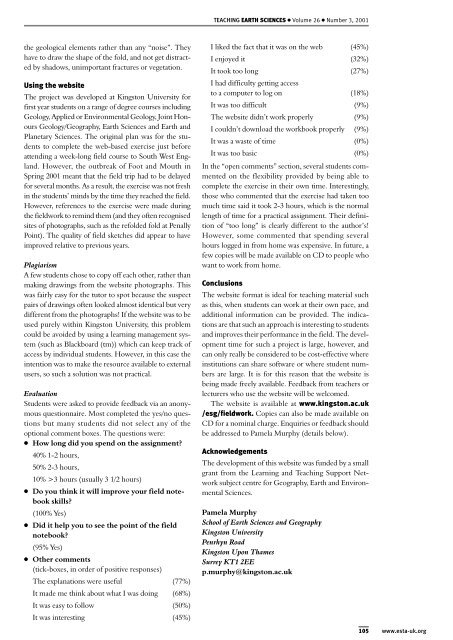teaching - Earth Science Teachers' Association
teaching - Earth Science Teachers' Association
teaching - Earth Science Teachers' Association
You also want an ePaper? Increase the reach of your titles
YUMPU automatically turns print PDFs into web optimized ePapers that Google loves.
TEACHING EARTH SCIENCES ● Volume 26 ● Number 3, 2001<br />
the geological elements rather than any “noise”. They<br />
have to draw the shape of the fold, and not get distracted<br />
by shadows, unimportant fractures or vegetation.<br />
Using the website<br />
The project was developed at Kingston University for<br />
first year students on a range of degree courses including<br />
Geology, Applied or Environmental Geology, Joint Honours<br />
Geology/Geography, <strong>Earth</strong> <strong>Science</strong>s and <strong>Earth</strong> and<br />
Planetary <strong>Science</strong>s. The original plan was for the students<br />
to complete the web-based exercise just before<br />
attending a week-long field course to South West England.<br />
However, the outbreak of Foot and Mouth in<br />
Spring 2001 meant that the field trip had to be delayed<br />
for several months. As a result, the exercise was not fresh<br />
in the students’ minds by the time they reached the field.<br />
However, references to the exercise were made during<br />
the fieldwork to remind them (and they often recognised<br />
sites of photographs, such as the refolded fold at Penally<br />
Point). The quality of field sketches did appear to have<br />
improved relative to previous years.<br />
Plagiarism<br />
A few students chose to copy off each other, rather than<br />
making drawings from the website photographs. This<br />
was fairly easy for the tutor to spot because the suspect<br />
pairs of drawings often looked almost identical but very<br />
different from the photographs! If the website was to be<br />
used purely within Kingston University, this problem<br />
could be avoided by using a learning management system<br />
(such as Blackboard (tm)) which can keep track of<br />
access by individual students. However, in this case the<br />
intention was to make the resource available to external<br />
users, so such a solution was not practical.<br />
Evaluation<br />
Students were asked to provide feedback via an anonymous<br />
questionnaire. Most completed the yes/no questions<br />
but many students did not select any of the<br />
optional comment boxes. The questions were:<br />
● How long did you spend on the assignment?<br />
40% 1-2 hours,<br />
50% 2-3 hours,<br />
10% >3 hours (usually 3 1/2 hours)<br />
● Do you think it will improve your field notebook<br />
skills?<br />
(100% Yes)<br />
● Did it help you to see the point of the field<br />
notebook?<br />
(95% Yes)<br />
● Other comments<br />
(tick-boxes, in order of positive responses)<br />
The explanations were useful (77%)<br />
It made me think about what I was doing (68%)<br />
It was easy to follow (50%)<br />
It was interesting (45%)<br />
I liked the fact that it was on the web (45%)<br />
I enjoyed it (32%)<br />
It took too long (27%)<br />
I had difficulty getting access<br />
to a computer to log on (18%)<br />
It was too difficult (9%)<br />
The website didn’t work properly (9%)<br />
I couldn’t download the workbook properly (9%)<br />
It was a waste of time (0%)<br />
It was too basic (0%)<br />
In the “open comments” section, several students commented<br />
on the flexibility provided by being able to<br />
complete the exercise in their own time. Interestingly,<br />
those who commented that the exercise had taken too<br />
much time said it took 2-3 hours, which is the normal<br />
length of time for a practical assignment. Their definition<br />
of “too long” is clearly different to the author’s!<br />
However, some commented that spending several<br />
hours logged in from home was expensive. In future, a<br />
few copies will be made available on CD to people who<br />
want to work from home.<br />
Conclusions<br />
The website format is ideal for <strong>teaching</strong> material such<br />
as this, when students can work at their own pace, and<br />
additional information can be provided. The indications<br />
are that such an approach is interesting to students<br />
and improves their performance in the field. The development<br />
time for such a project is large, however, and<br />
can only really be considered to be cost-effective where<br />
institutions can share software or where student numbers<br />
are large. It is for this reason that the website is<br />
being made freely available. Feedback from teachers or<br />
lecturers who use the website will be welcomed.<br />
The website is available at www.kingston.ac.uk<br />
/esg/fieldwork. Copies can also be made available on<br />
CD for a nominal charge. Enquiries or feedback should<br />
be addressed to Pamela Murphy (details below).<br />
Acknowledgements<br />
The development of this website was funded by a small<br />
grant from the Learning and Teaching Support Network<br />
subject centre for Geography, <strong>Earth</strong> and Environmental<br />
<strong>Science</strong>s.<br />
Pamela Murphy<br />
School of <strong>Earth</strong> <strong>Science</strong>s and Geography<br />
Kingston University<br />
Penrhyn Road<br />
Kingston Upon Thames<br />
Surrey KT1 2EE<br />
p.murphy@kingston.ac.uk<br />
105 www.esta-uk.org

















